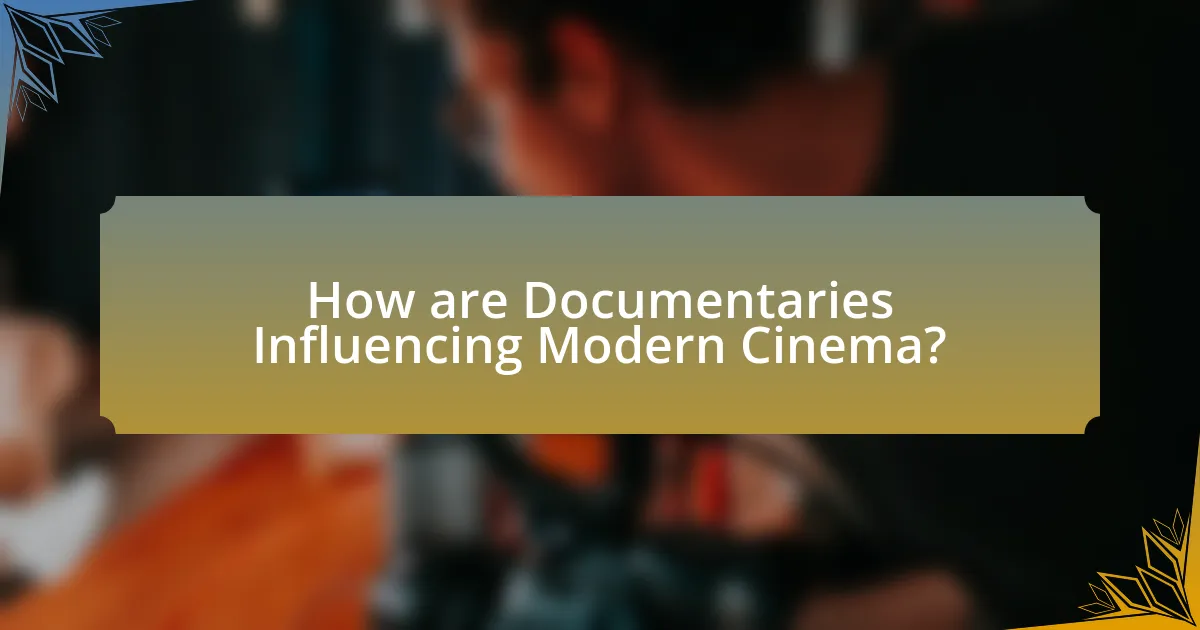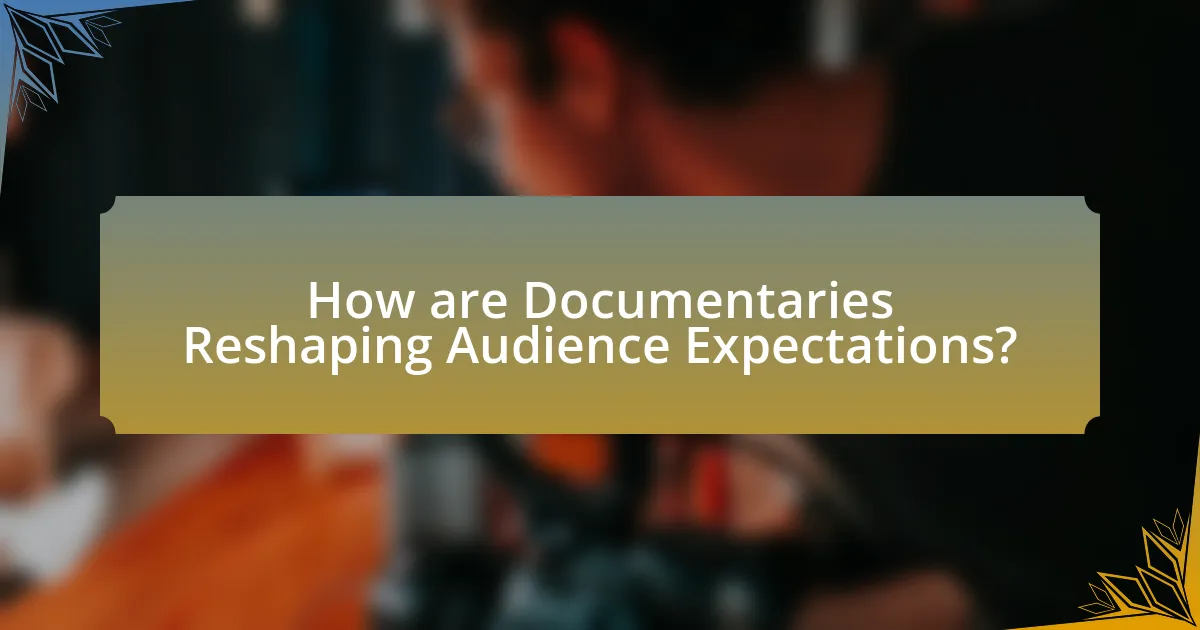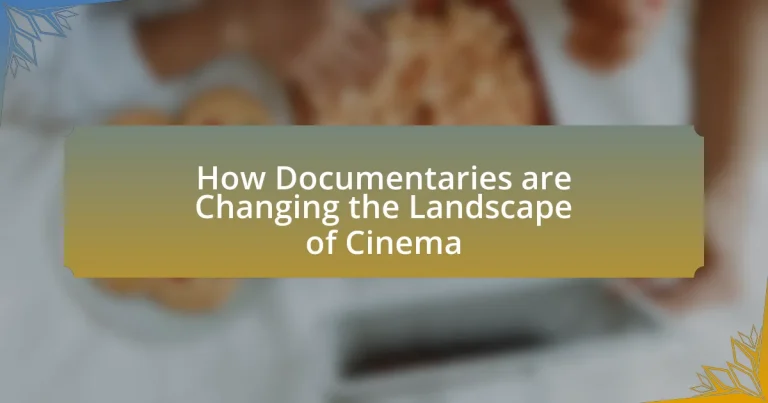Documentaries are significantly reshaping the landscape of modern cinema by introducing innovative storytelling techniques and emphasizing authenticity. This article explores how contemporary documentaries blend factual content with narrative elements, utilize advanced technology, and address pressing social issues, thereby influencing audience expectations and engagement. Key characteristics of modern documentaries, such as immersive storytelling and personal narratives, are examined alongside the impact of streaming platforms and social media on distribution and viewer interaction. Additionally, the article discusses emerging trends in documentary filmmaking and the role of audience demographics in shaping content, highlighting the importance of authenticity and emotional resonance in effective documentary storytelling.

How are Documentaries Influencing Modern Cinema?
Documentaries are influencing modern cinema by introducing innovative storytelling techniques and fostering a greater emphasis on authenticity. This shift is evident in the blending of documentary styles with narrative films, as seen in works like “The Act of Killing” and “American Factory,” which utilize real-life events and interviews to enhance emotional engagement. Furthermore, the rise of streaming platforms has increased the accessibility of documentaries, allowing filmmakers to reach wider audiences and inspire narrative filmmakers to incorporate documentary elements into their storytelling. This trend is supported by the growing popularity of docudramas and biopics, which often draw from documentary sources to create compelling narratives, thereby reshaping audience expectations and cinematic conventions.
What are the key characteristics of contemporary documentaries?
Contemporary documentaries are characterized by their emphasis on storytelling, diverse perspectives, and innovative techniques. These films often blend factual content with narrative elements, creating engaging and relatable stories that resonate with audiences. Additionally, contemporary documentaries frequently utilize modern technology, such as high-definition cameras and digital editing software, to enhance visual storytelling and accessibility. The rise of streaming platforms has also expanded the reach of documentaries, allowing for a wider variety of topics and voices to be represented. This evolution reflects a shift towards more personal and immersive experiences, as filmmakers increasingly focus on social issues, personal narratives, and interactive formats, thereby transforming the documentary genre within the cinematic landscape.
How do these characteristics differentiate documentaries from traditional films?
Documentaries differentiate from traditional films primarily through their focus on real-life events and factual storytelling. Unlike traditional films, which often prioritize fictional narratives and character development, documentaries aim to present actual occurrences, interviews, and evidence-based content. This distinction is evident in the use of real footage, expert testimonies, and a commitment to authenticity, which are hallmarks of the documentary genre. For instance, the documentary “13th” by Ava DuVernay explores the historical context of racial inequality in the United States using archival footage and expert interviews, contrasting sharply with fictional films that create narratives for entertainment rather than education.
What storytelling techniques are commonly used in modern documentaries?
Modern documentaries commonly use techniques such as immersive storytelling, character-driven narratives, and the integration of archival footage. Immersive storytelling engages viewers by placing them directly in the experience, often through first-person perspectives or participatory approaches, which enhances emotional connection. Character-driven narratives focus on personal stories, allowing audiences to relate to individuals and their journeys, making complex topics more accessible. The integration of archival footage provides historical context and authenticity, grounding the narrative in real events and experiences. These techniques collectively enhance the documentary’s impact, making it a powerful medium for storytelling in contemporary cinema.
Why is the rise of documentaries significant for the film industry?
The rise of documentaries is significant for the film industry because it reflects a growing audience demand for authentic storytelling and real-world issues. This shift has led to increased funding and production of documentary films, with the global documentary market valued at approximately $2.5 billion in 2020, indicating a robust interest in non-fiction narratives. Furthermore, documentaries have gained recognition at major film festivals, with films like “13th” and “My Octopus Teacher” receiving critical acclaim and awards, showcasing their impact on cultural discourse and the industry’s evolution.
How do documentaries challenge conventional cinematic narratives?
Documentaries challenge conventional cinematic narratives by prioritizing factual storytelling over fictional constructs. Unlike traditional films that often follow scripted plots and character arcs, documentaries present real-life events and perspectives, emphasizing authenticity and truth. For instance, films like “The Act of Killing” and “13th” utilize interviews and archival footage to confront historical injustices, thereby reshaping audience perceptions and encouraging critical thinking. This approach disrupts the typical narrative structure by focusing on real-world issues, fostering a deeper engagement with the subject matter and prompting viewers to question established narratives.
What impact do documentaries have on audience perceptions and engagement?
Documentaries significantly shape audience perceptions and engagement by providing factual narratives that inform and evoke emotional responses. Research indicates that documentaries can alter viewers’ attitudes and beliefs, as evidenced by a study published in the Journal of Communication, which found that exposure to documentary films can lead to increased awareness and concern about social issues. This impact is further reinforced by the immersive storytelling techniques employed in documentaries, which enhance viewer connection and empathy towards the subjects presented. Consequently, documentaries not only educate audiences but also motivate them to engage with the issues depicted, fostering a more informed and active public.

What Trends are Emerging in Documentary Filmmaking?
Emerging trends in documentary filmmaking include the rise of interactive and immersive storytelling, increased use of technology such as virtual reality, and a focus on social justice themes. Interactive documentaries allow viewers to engage with content in a non-linear fashion, enhancing their emotional connection to the subject matter. The integration of virtual reality has transformed the viewing experience, making it more immersive and impactful, as seen in projects like “The Displaced,” which allows users to experience the lives of refugees firsthand. Additionally, documentaries are increasingly addressing pressing social issues, with films like “13th” and “I Am Not Your Negro” sparking conversations around race and justice, reflecting a broader societal demand for accountability and change. These trends indicate a shift towards more engaging, relevant, and socially conscious documentary filmmaking.
How is technology shaping the production of documentaries?
Technology is significantly shaping the production of documentaries by enhancing accessibility, improving quality, and enabling innovative storytelling techniques. Advances in camera technology, such as high-definition and 4K resolution, allow filmmakers to capture stunning visuals that engage audiences more effectively. Additionally, the proliferation of affordable equipment, including drones and smartphones, democratizes documentary filmmaking, enabling a broader range of voices and perspectives to be represented.
Furthermore, editing software has become more sophisticated and user-friendly, allowing filmmakers to streamline the post-production process and experiment with narrative structures. The rise of streaming platforms has also transformed distribution, providing filmmakers with direct access to global audiences and reducing reliance on traditional broadcasting channels. According to a report by the International Documentary Association, the number of documentaries produced has increased significantly in recent years, reflecting the impact of these technological advancements on the industry.
What role do streaming platforms play in the distribution of documentaries?
Streaming platforms serve as crucial distribution channels for documentaries, significantly expanding their reach and accessibility. These platforms, such as Netflix, Amazon Prime Video, and Hulu, provide a global audience for documentary filmmakers, allowing content that might not receive theatrical releases to find viewers. According to a 2021 report by the International Documentary Association, streaming services accounted for over 50% of documentary viewership, highlighting their impact on audience engagement. This shift has democratized access to diverse narratives, enabling independent filmmakers to showcase their work alongside major productions, thus transforming the documentary landscape in cinema.
How has social media influenced documentary storytelling?
Social media has significantly influenced documentary storytelling by providing filmmakers with immediate access to diverse audiences and facilitating real-time engagement. This shift allows documentarians to gather feedback, share their work, and promote social issues more effectively. For instance, platforms like Twitter and Instagram enable filmmakers to create viral campaigns that can amplify their narratives, as seen with the documentary “13th,” which gained traction through social media discussions around racial injustice. Additionally, social media encourages participatory storytelling, where audiences can contribute their perspectives, enhancing the depth and relatability of documentary content.
What themes are prevalent in recent documentary films?
Recent documentary films frequently explore themes of social justice, environmental issues, and personal identity. Social justice themes often highlight systemic inequalities, as seen in films like “13th,” which examines racial injustice in the United States. Environmental issues are prominently featured in documentaries such as “Our Planet,” which addresses climate change and biodiversity loss. Additionally, personal identity is a recurring theme, with films like “Disclosure” focusing on transgender representation in media. These themes reflect contemporary societal concerns and resonate with audiences, demonstrating the evolving role of documentaries in addressing critical issues.
How do social issues drive the content of contemporary documentaries?
Social issues significantly drive the content of contemporary documentaries by shaping the narratives and themes that filmmakers choose to explore. Documentaries often address pressing societal challenges such as climate change, racial inequality, and mental health, reflecting the concerns and values of the current era. For instance, the documentary “13th” by Ava DuVernay examines the intersection of race, justice, and mass incarceration in the United States, highlighting systemic racism and its historical roots. This focus on social issues not only raises awareness but also fosters public discourse, encouraging audiences to engage with and reflect on these critical topics.
What role does personal narrative play in modern documentary filmmaking?
Personal narrative plays a crucial role in modern documentary filmmaking by providing an intimate lens through which audiences can connect with the subject matter. This approach allows filmmakers to share personal experiences and perspectives, making complex social issues more relatable and emotionally resonant. For instance, documentaries like “Won’t You Be My Neighbor?” utilize personal narratives to explore the life of Fred Rogers, effectively humanizing broader themes of kindness and community. By incorporating personal stories, filmmakers can evoke empathy and foster a deeper understanding of the subjects they portray, thereby transforming the viewer’s experience and engagement with the documentary format.

How are Documentaries Reshaping Audience Expectations?
Documentaries are reshaping audience expectations by providing authentic narratives that challenge traditional storytelling methods in cinema. This shift is evident as viewers increasingly seek factual content that reflects real-world issues, leading to a demand for transparency and depth in storytelling. According to a 2021 report by the Pew Research Center, 73% of Americans believe documentaries help them understand complex issues better, indicating a growing expectation for informative and engaging content. As a result, filmmakers are adapting their approaches to meet these demands, often blending cinematic techniques with journalistic integrity to enhance viewer engagement and satisfaction.
What are the viewing habits of documentary audiences today?
Documentary audiences today primarily consume content through streaming platforms, with a significant shift towards on-demand viewing. According to a 2022 report by the Pew Research Center, 63% of U.S. adults watch documentaries on streaming services like Netflix and Hulu, reflecting a preference for convenience and accessibility. Additionally, audiences are increasingly engaging with shorter formats, such as web series and social media clips, which cater to the fast-paced consumption habits of younger viewers. This trend indicates a growing demand for diverse documentary styles that fit into varied viewing schedules, further transforming the landscape of documentary filmmaking.
How do audience demographics influence documentary content?
Audience demographics significantly influence documentary content by shaping the themes, narratives, and presentation styles that resonate with specific viewer groups. For instance, younger audiences may prefer documentaries that address contemporary social issues, such as climate change or digital culture, while older demographics might gravitate towards historical narratives or biographical stories. Research from the Pew Research Center indicates that 64% of adults aged 18-29 consume documentaries regularly, highlighting a preference for content that reflects their values and interests. This demographic insight drives filmmakers to tailor their projects to engage these audiences effectively, ensuring relevance and viewer connection.
What expectations do viewers have regarding authenticity in documentaries?
Viewers expect authenticity in documentaries to reflect real events, truthful narratives, and genuine perspectives. This expectation stems from the belief that documentaries serve as a reliable source of information and insight into various subjects. Research indicates that audiences are more likely to trust documentaries that present verifiable facts and include diverse viewpoints, as seen in studies conducted by the Pew Research Center, which found that 63% of viewers prioritize factual accuracy in documentary films. Additionally, viewers often seek emotional resonance and relatable experiences, which further reinforces their demand for authenticity in storytelling.
What can filmmakers do to enhance the impact of their documentaries?
Filmmakers can enhance the impact of their documentaries by employing compelling storytelling techniques that engage audiences emotionally and intellectually. By focusing on character-driven narratives, filmmakers can create relatable and memorable experiences that resonate with viewers. For instance, the documentary “Won’t You Be My Neighbor?” effectively used personal stories of Fred Rogers to evoke empathy and connection, resulting in a significant box office success and critical acclaim. Additionally, incorporating high-quality visuals and sound design can elevate the overall production value, making the documentary more immersive. Research indicates that documentaries with strong visual elements can increase viewer retention and emotional response, as seen in studies published by the Journal of Visual Communication in Medicine. By combining these strategies, filmmakers can significantly enhance the effectiveness and reach of their documentaries.
How can filmmakers effectively engage audiences through innovative storytelling?
Filmmakers can effectively engage audiences through innovative storytelling by utilizing immersive techniques such as interactive narratives and multi-platform experiences. These methods allow viewers to participate actively in the story, enhancing emotional investment and connection. For instance, documentaries like “The Act of Killing” employ unconventional storytelling by blending reenactments with real-life testimonies, which challenges viewers’ perceptions and evokes strong emotional responses. This approach has been shown to increase audience engagement, as evidenced by the film’s critical acclaim and its ability to spark discussions on complex historical issues.
What best practices should filmmakers follow to ensure their documentaries resonate with viewers?
Filmmakers should focus on storytelling, authenticity, and audience engagement to ensure their documentaries resonate with viewers. Effective storytelling involves crafting a compelling narrative that connects emotionally with the audience, as seen in successful documentaries like “13th,” which explores systemic racism through personal stories and historical context. Authenticity is crucial; filmmakers must present factual information and genuine perspectives, as demonstrated by “Won’t You Be My Neighbor?” which portrays Fred Rogers’ life with honesty and depth. Lastly, engaging the audience through interactive elements or social media can enhance viewer connection, as evidenced by the success of documentaries that encourage discussions and community involvement.


